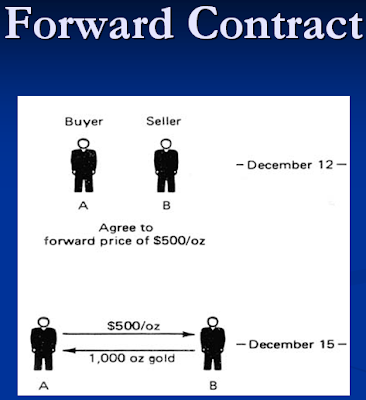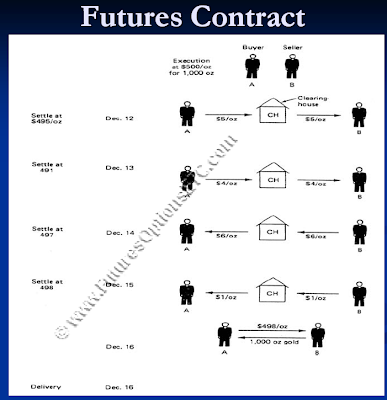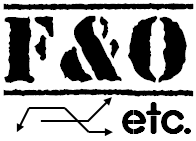|
|
In this article, we will cover the Commodity Futures i.e. futures with an underlying as Commodity like Gold, Silver, Crude Oil, Soya, Corn or anything that qualifies as a commodity. These futures can be exchange traded futures like those on Chicago Board of Trade (CME Group) CBOT, Chicago Mercantile Exchange CME or New York Mercantile Exchange NYMEX or can be OTC (Over the counter) between two parties on mutually agreed terms.
The exchange traded Commodity futures may require daily settlement and movement of margin money, while the OTC Commodity futures may not need daily margin requirements depending upon the futures agreement.
Let's start with the basics first:
What is a Commodity Future or Future on Commodity?
As we all are aware, a futures contract is an agreement between two parties to trade a particular asset at a fixed price on a fixed date in future.
Commodity futures are those future contracts which have the underlying asset as a Commodity. Usually, spot prices from any spot exchanges are used as underlying benchmark for commodity futures. Like any other futures contract, Commodity futures have an expiry date and the futures price. On the expiry date, the buyer delivers the agreed price to the seller and the seller gives over the Commodity to the buyer.
Let's see an example.
Can we have an example of Commodity Futures
Yes. Let's say there are two traders - Bunny the buyer and Sunny the seller.
Assume that "Gold" is currently trading at $100 per Oz in the open market or exchange. Assume today is 1 January.
Bunny the buyer believes that in 3 months time (say by 31st March), Gold prices will shoot up higher and will reach the price of $110.
Sunny the seller believes that in 3 months time, the Gold prices will trade lower and will reach the price of $90.
So both these Commodity traders have opposing outlook on the same Commodity (Gold) but for the same time period and they decide to go for a futures contract on this Gold Commodity as an underlying.
Since they both have a 3 month horizon on 1 January, here are the futures contract specification:
Underlying asset - Gold (it's current price)
Spot Price of Unerlying - $100 (Price as of today)
Trade Date - the day on which futures contract is agreed i.e. today - 1 January
Futures Expiry Date - Date on which the actual exchange will happen - 31 March
Futures Price - Say they both agree to trade this for $102 - this becomes the futures price.
Contract Size - 100 Oz of Gold (assume they both want to trade 100 Oz of gold as a part of this futures contract on gold)
Usually the Contract size is defined by the exchange for small individual traders.
So what will happen on Expiry date of 31st March?
Sunny will deliver 100 Oz of Gold to Bunny on 31 March.
Bunny will give 100 * 101 $ (contract size * futures price) = 10100 USD to Sunny. Effectively, $101 per Oz of Gold.
Commodity Futures Trading Explained with a Trade Example
How will this Commodity Futures trade benefit either of the futures traders?
In futures trading, one man's profit is other man's loss and vice versa.
Suppose Bunny's prediction comes true. His prediction was that by expiry date, the Gold prices will shot upto $110.
In this case, since the futures price they both agreed upon is $101, Bunny will benefit. He will get the Gold at the rate of $101 only and can sell it in the market at $110 to make a profit of $9 per Commodity.
Sunny will suffer the loss because he may either have to purchase the Gold from open market at the price of $110 and give it to Bunny for only $101. OR, he may have purchased Gold long time back at cheap price (say $50), but instead of selling them at market price of $110, he is forced to sell it to Bunny at $101 (the agreed futures price). In either case, he has to suffer the loss of $9 per Oz of Gold.
Bunny profit comes at the expense of Sunny's loss.
Let's see other scenario as well. Suppose that Sunny's prediction comes true and by expiry date, the Gold Commodity prices comes down to $90.
Sunny will now benefit, because he will get $101 from Bunny for a Commodity that is currently trading at $90 only. After receiving $101 from Bunny, Sunny can buy them in the open market at just $90 and make immediate profit of $11 per Oz of Gold.
Bunny suffers the loss because he now needs to pay $101 for something which is available at just $90 in the market.
Sunny's profit come at the expense of Bunny's loss.
How does Commodity Futures trading work in real life?
In realistic scenarios - no exchange actually takes place for Commodity. Everything is settled in money.
Sunny does not need to provide any actual Gold to Bunny - whatever is the price differential, that is transferred to the winning party from the loosing party.
Also note that if this is an exchange traded Commodity future, then there can be margin requirements as well as daily settlement of margins. Margin requirements on futures means both the parties assessing their positions at the end of each day and the loosing party providing margin money via the exchange to the winning party.
For eg, on each day between 1 January to 31 March (i.e. between trade date and expiry date), both Bunny and Sunny will have to assess their trade positions profit and loss at the end of the day. If at that end of the day, Bunny is in profit and Sunny is in loss, then Sunny needs to provide margin money to Bunny (via the exchange) to remain in the futures position).
The margin requirements are usually set by the exchanges as well as the brokers who act as intermediaries.
In case this Commodity future trade is over the counter or OTC, then margin money requirements may not apply on daily basis, based on the mutual agreement.
What decides the Commodity Futures prices?
In case of any futures contract defined on any underlying, the price of the underlying usually decides the price of its futures.
In case of Commodity futures, the price of the underlying Commodity will be the major factor in determining the Commodity futures prices.
Other than that, the interest rate, risk premium, time to expiry and cost of carry are other factors which may have an influence on price of Commodity futures.
What is the difference between Commodity Futures and Commodity Forwards?
The simple difference between a forward and a future contract is that forward contract is NOT through an exchange while future usually is on an exchange.
Also, futures contract require margin money, while forwards may not.
Forward Contract Example

Futures Contract Example

See these images to see how a forward contract on gold will differ from a similar future contract on gold with respect to margin money & daily settlement requirements in case of futures contract (Click on images to enlarge)
Commodity Futures

0 Comments: Post your Comments
Wish you all profitable derivatives trading and investing activities with safety! = = Post a Comment